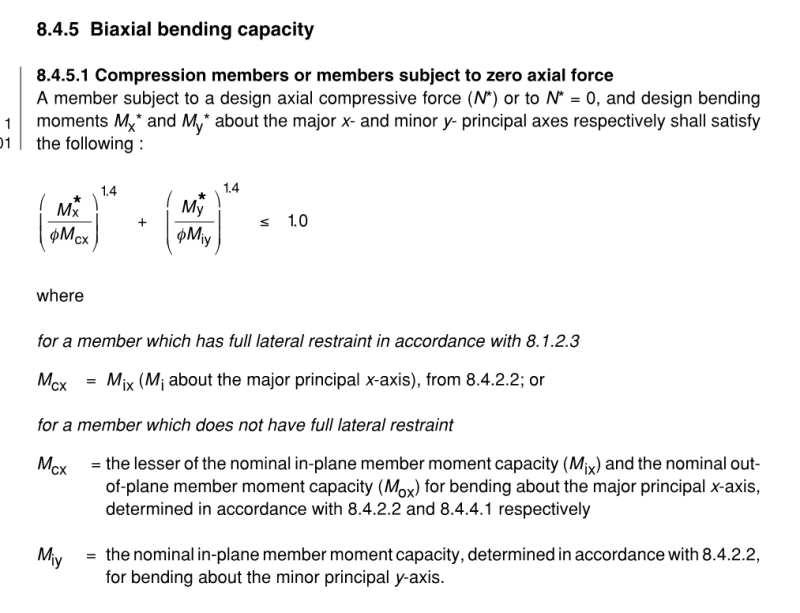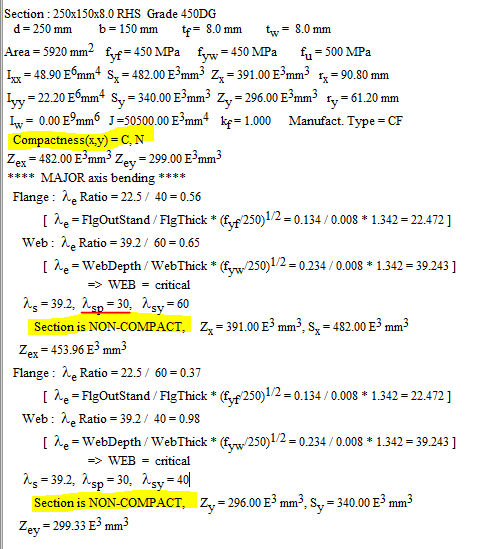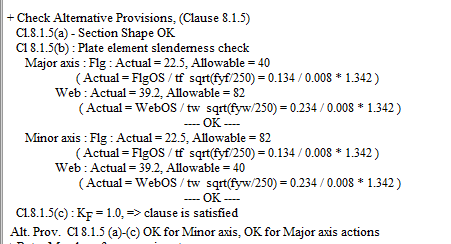Agent666
Structural
- Jul 2, 2008
- 3,080
What are peoples thoughts on this situation:-
Both AS & NZ steel standards allow the use of alternative design provisions for combined actions, i.e. if section is compact, is a doubly symmetric I section or a square hollow section alternative equations can be used in chapter 8. NZ code has some further qualifying provisions for applying these alternative provisions on top of the smaller subset of requirements in AS4100. These relate to alternative slenderness requirements and axial load limits but are not important with regard to the intent of this query.
I was wondering what peoples interpretation of 'compactness' is in terms of application of these provisions, say we have the situation whereby a rectangular hollow section is compact about major axis but non-compact or even slender about the minor axis.
1. If section is subject to only major axis bending then you'd only need to be compact about this axis to use the alternative provisions, so our example RHS would satisfy this requirement?
2. If section is subject to only minor axis bending then I'd say you cannot use the alternative design provisions as you are not compact about this axis. This aspect seems clear to me as the intent of the standards.
3. If section is subject to biaxial bending then you'd need to be compact about both axes to use the alternative provisions.
4. Or would you only apply the alternative design provisions if the section was compact about both axes even if there was only uniaxial bending?
Keep in mind the alternative provisions are a means of allowing for more capacity due to allowing some yielding and inelastic action within the cross section provided it doesn't impact on member stability and the like. So it makes sense to me at least that you should only need to consider the compactness about the axis of loading to achieve this increase as element slenderness is satisfied about that axis?
Any agreement/disagreement/comments with this approach?
I have not been able to find anything which states definitely one way or the other if a single axis of being compact is ok vs requiring both to correctly apply these provisions.
Thanks
Both AS & NZ steel standards allow the use of alternative design provisions for combined actions, i.e. if section is compact, is a doubly symmetric I section or a square hollow section alternative equations can be used in chapter 8. NZ code has some further qualifying provisions for applying these alternative provisions on top of the smaller subset of requirements in AS4100. These relate to alternative slenderness requirements and axial load limits but are not important with regard to the intent of this query.
I was wondering what peoples interpretation of 'compactness' is in terms of application of these provisions, say we have the situation whereby a rectangular hollow section is compact about major axis but non-compact or even slender about the minor axis.
1. If section is subject to only major axis bending then you'd only need to be compact about this axis to use the alternative provisions, so our example RHS would satisfy this requirement?
2. If section is subject to only minor axis bending then I'd say you cannot use the alternative design provisions as you are not compact about this axis. This aspect seems clear to me as the intent of the standards.
3. If section is subject to biaxial bending then you'd need to be compact about both axes to use the alternative provisions.
4. Or would you only apply the alternative design provisions if the section was compact about both axes even if there was only uniaxial bending?
Keep in mind the alternative provisions are a means of allowing for more capacity due to allowing some yielding and inelastic action within the cross section provided it doesn't impact on member stability and the like. So it makes sense to me at least that you should only need to consider the compactness about the axis of loading to achieve this increase as element slenderness is satisfied about that axis?
Any agreement/disagreement/comments with this approach?
I have not been able to find anything which states definitely one way or the other if a single axis of being compact is ok vs requiring both to correctly apply these provisions.
Thanks







